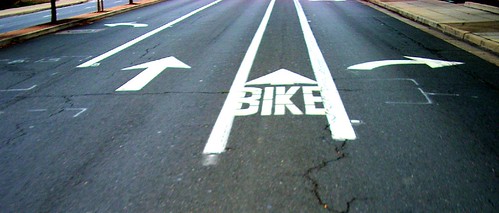California Governor Jerry Brown signed AB 2245 into law yesterday. AB 2245 exempts bicycle lanes from the environmental review requirement in the California Environmental Quality Act (CEQA).

The bill as originally authored by Republican Assembly member Cameron Smyth in Santa Clarita was a thing of beauty. It simply read:
THE PEOPLE OF THE STATE OF CALIFORNIA DO ENACT AS FOLLOWS:
SECTION 1. Section 21080.38 is added to the Public Resources Code, to read:
21080.38. This division does not apply to a project for bikeways, as defined in Section 890.4 of the Streets and Highways Code, undertaken by a city or county within an existing road right-of-way.
Section 21080.38 refers to the CEQA. Any bikeway project was completely exempt from environmental review. No fuss, no muss.
The Assembly Natural Resources Committee got their fingers on this, restricted its scope to painted bicycle lanes “as specified in subdivision b of Section 890.4 of the Streets and Highways Code,” added a requirement for a traffic and safety impact assessment and public hearings, and added a sunset clause.
Wait, there’s more! After this bill wound it’s way through the Senate Appropriations Committee and the full Senate, the exemption is only for bike lanes in urbanized areas that is “consistent with a prepared bicycle transportation plan.” The proposed bike lane plan needs to be vetted by the California Office of Planning & Research (OPR).
Here’s what the final bill as signed by Governor Brown looks like.
THE PEOPLE OF THE STATE OF CALIFORNIA DO ENACT AS FOLLOWS:
SECTION 1. Section 21080.20.5 is added to the Public Resources
Code, to read:
21080.20.5. (a) This division does not apply to a project that
consists of the restriping of streets and highways for bicycle lanes
in an urbanized area that is consistent with a bicycle transportation
plan prepared pursuant to Section 891.2 of the Streets and Highways
Code.
(b) Prior to determining that a project is exempt pursuant to this
section, the lead agency shall do both of the following:
(1) Prepare an assessment of any traffic and safety impacts of the
project and include measures in the project to mitigate potential
vehicular traffic impacts and bicycle and pedestrian safety impacts.
(2) Hold noticed public hearings in areas affected by the project
to hear and respond to public comments. Publication of the notice
shall be no fewer times than required by Section 6061 of the
Government Code, by the public agency in a newspaper of general
circulation in the area affected by the proposed project. If more
than one area will be affected, the notice shall be published in the
newspaper of largest circulation from among the newspapers of general
circulation in those areas.
(c) (1) Whenever a state agency determines that a project is not
subject to this division pursuant to this section, and it determines
to approve or carry out that project, the notice shall be filed with
the Office of Planning and Research in the manner specified in
subdivisions (b) and (c) of Section 21108.
(2) Whenever a local agency determines that a project is not
subject to this division pursuant to this section, and it determines
to approve or carry out that project, the notice shall be filed with
the Office of Planning and Research, and filed with the county clerk
in the county in which the project is located in the manner specified
in subdivisions (b) and (c) of Section 21152.
(d) This section shall remain in effect only until January 1,
2018, and as of that date is repealed, unless a later enacted
statute, that is enacted before January 1, 2018, deletes or extends
that date.
That’s 368 words vs 60 words.
This is still a win for local agencies working to install bike facilities around the state, but it does give them a couple of bureaucratic hoops to jump through. Christoper Kidd of Alta Planning explains that this new law requires about half the time and money of a full blown CEQA EIR. “Studies won’t have to use absurd 30-year traffic projections when looking at LOS impacts,” he writes via Twitter. “The [Association of Bay Area Goverments] 30-year traffic volume projections are particularly bad. Getting to ignore them [is] a big boost for bay area projects.”
H/T to LA DOT.
This is probably not a bad law by itself, but perhaps the process gets pried open to allow things that aren’t bike lanes to bypass review.
I’m sorry to see it was watered down. Is that what it took to pass?
Why make things easy when you can make them complicated? I’m an outsider to legalese and I know that compromise is important, but it is too bad the legislation has a sunset clause and is so constricted. That beiing said, it’s still a step forward for more rational transportation policy.